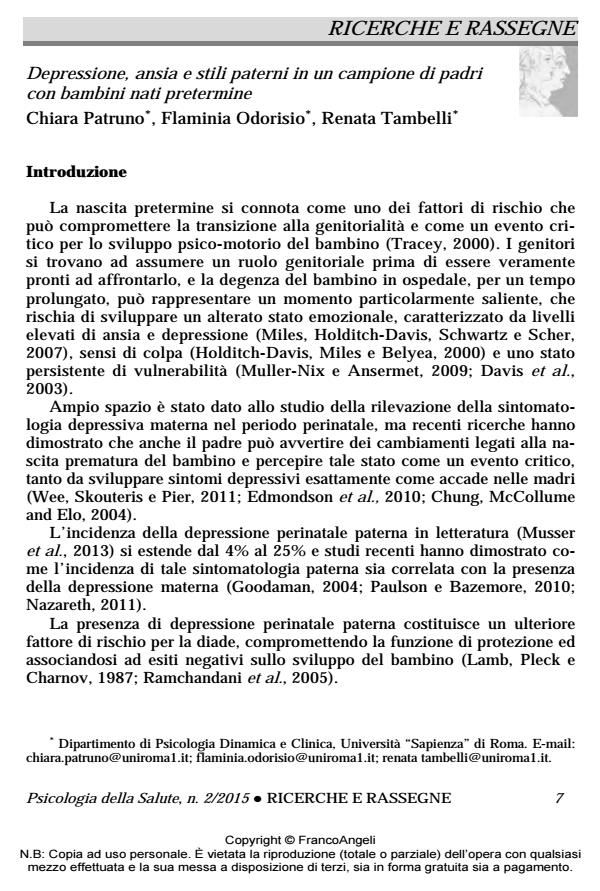Depressione, ansia e stili paterni in un campione di padri con bambini nati pretermine
Titolo Rivista PSICOLOGIA DELLA SALUTE
Autori/Curatori Chiara Patruno, Flaminia Odorisio, Renata Tambelli
Anno di pubblicazione 2015 Fascicolo 2015/2
Lingua Italiano Numero pagine 19 P. 7-25 Dimensione file 124 KB
DOI 10.3280/PDS2015-002002
Il DOI è il codice a barre della proprietà intellettuale: per saperne di più
clicca qui
Qui sotto puoi vedere in anteprima la prima pagina di questo articolo.
Se questo articolo ti interessa, lo puoi acquistare (e scaricare in formato pdf) seguendo le facili indicazioni per acquistare il download credit. Acquista Download Credits per scaricare questo Articolo in formato PDF

FrancoAngeli è membro della Publishers International Linking Association, Inc (PILA)associazione indipendente e non profit per facilitare (attraverso i servizi tecnologici implementati da CrossRef.org) l’accesso degli studiosi ai contenuti digitali nelle pubblicazioni professionali e scientifiche
L’obiettivo del presente studio è stato quello di valutare i vissuti di depressione e ansia di padri di neonati prematuri e come questi potessero associarsi alle rappresentazioni paterne e alla disponibilità emotiva in un’interazione di gioco libera. È stato selezionato un gruppo di 68 padri, a cui sono stati somministrati i seguenti strumenti: il self-report STAI-Y1 per rilevare l’ansia di stato; l’EPDS per valutare la sintomatologia depressiva; l’intervista IRPAN per valutare la rappresentazione paterna al 4° mese di età corretta e la videoregistrazione delle sequenze interattive, codificate mediante scale di valutazione dell’interazione EAS, al 6° mese. I risultati hanno messo in luce che i padri di bambini prematuri mostrano un rischio ansioso nel 32%, depressivo nel 19%, una prevalenza di rappresentazioni integrate/equilibrate nel 50%, ristrette/disinvestite nel 45% e non integrate/ ambivalenti nel 4%. I padri ansiosi del nostro studio hanno un’interazione meno efficace rispetto a quelli che non presentano una sintomatologia ansiosa, dimostrando di essere meno sensibili, non strutturano efficacemente l’interazione ludica, divenendo in alcuni momenti intrusivi. I bambini di questi padri sono meno coinvolti nell’interazione con l’adulto. I risultati hanno mostrato che i padri depressi sono meno sensibili nell’interazione con i loro bambini. I dati relativi alla rappresentazione paterna e l’interazione hanno mostrato come i padri con una rappresentazione integrata/equilibrata, pur mostrando dei livelli elevati di ansia, si caratterizzano per essere in grado di strutturare efficacemente l’interazione ludica a differenza delle altre categorie di rappresentazione, dimostrando come il fattore ansia sia funzionale alle loro capacità.
Parole chiave:Nascita prematura, genitorialità, depressione paterna, ansia paterna, rappresentazioni paterne, interazioni padre-bambino
Chiara Patruno, Flaminia Odorisio, Renata Tambelli, Depressione, ansia e stili paterni in un campione di padri con bambini nati pretermine in "PSICOLOGIA DELLA SALUTE" 2/2015, pp 7-25, DOI: 10.3280/PDS2015-002002